
Palm Oil Refinery Plant
Get Price Quote
We are manufacturer, exporter & supplier of Palm Oil Refinery Plant. As per the today’s market research it is being concluded that the market demands the refined edible oil with characteristics such as blend flavour and odour, clear appearance, light colour, long shelf life, suitable for frying since the crude oil obtain does contain many harmful factors like free fatty acid, sediments, gums, odoriferous compound and other impurities. GOYUM with an experience of more than 5 decades in the Edible oil industry have worked unremittingly in more than 60 countries of the world and have developed overall solutions for the Edible oil refinery needs of the customers. GOYUM provides complete solution for Palm Oil Refinery Plant, capacity to design, build and supply plants from 5 - 30 TPD Batch Type & 50 - 500 TPD Continuous Type Refinery. Edible Oil Refinery Plant Process : Bleaching Remove colouring pigments, traces of gums and metallic impurities Improve physical appearance Lower Bleaching earth consumption Uniform mixing of oil and earth Maintenance free Bleacher No dead area in Bleacher No carryover to Vacuum System Lower percentage of oil in Spent Cakes Deodorization Efficient removal of more volatile component like Free fatty acids, minor amount of colouring pigments Remove odoriferous compound Remove minor amount of colouring pigments Maximum heat transfer area Lower utility consumption Maximum Heat Recovery Zero contamination Elaborated and efficient design for the removal of fatty acid in Physical type DEO Longer shelf life of oil Very Low Maintenance Palm Oil Fractionation Larger heat transfer area with regard to the oil charge in the crystallizers. Optimal position of the heat exchange surfaces with regard to the impellers and therefore to the oil circulation in the vessel. All parts of the processed oil are really driven too close to the heat exchange surfaces. The cooling program is accurately followed. Granulation by step cooling.

refinery plant
3,000,000 - 5,000,000 Per unit
100 100 TPD (MOQ)
Best Deals from Refinery Plants

edible oil refinery plants
5,400,000 - 6,000,000 Per PLANT
1 Piece (MOQ)
We are the leading supplier of Edible Oil Refinery Plant made from high quality material at competitive prices.

silver refining plants
Get Price Quote
1 Piece (MOQ)

glycerine refining plant
Get Price Quote
1 Piece (MOQ)
Backdrop :Glycerine, as we know, has diverse utilities across industries around the globe. Food, pharmaceuticals, and cosmetics are the major consumers among them. Unfortunately, India still has a lot to do about tapping the opportunity of global export, which stands at a meager 0.33% only with respect to the global demand. Such a pitiful scenario may be ascribed to quality and costing issues persistently plaguing Indian glycerine refining industries.We have a pretty straightforward solution to this problem and have a well-thought-out plan that can potentially give a huge boost to our industry. But before we get into these details, let's have a discussion on how the thing works and how we are so relevant to this.How does glycerine refining work? Crude Glycerol sourced from various industrial chemical processes such as Oil Processing, Fats Splitting, Hydrolysis, Saponification, Transesterification, etc., are parsed through a series of following unit processes and operations to achieve the desired purity of glycerine. As one of the leading glycerine refining plant manufacturers, here, we have walked you through the process of purification of glycerine.Step 1 : Glycerine Intake and Pretreatment: The process is defined by the feeding of crude glycerol laden with various impurities, including methanol, salts, soap, fatty acids, and undesirable odor compounds, from the said sources. The objective of this section is to unburden the feed from particulate impurities, soap, methanol partially, and water and homogenize the mixture to make it a perfect feed for the next section. Treated with sulphuric acid, the soap and free oil content is transformed into free fatty acid, which is neutralized and removed by caustic lye. Following this, running through a decanting chamber or column, the glycerol is stripped of all lightweight impurities by phase separation in order to get more pure glycerol.Step 2 : Dehydration: Glycerol, typically obtained from the previous step, contains residual water and methanol along with other miscible impurities. We engineered the flash removal unit for methanol and then the heat exchanger for moisture removal to ensure maximum removal efficiency with low energy cost.Step 3 : Decolorization: The Crude glycerol can exhibit a dark color due to miscible impurities and contaminants. Decolorization is the art of restoring clarity to glycerine. We designed a bleaching unit in which activated carbon or other specialized adsorbents are applied to treat the glycerine stream, which selectively captures and removes color-causing impurities. Following this, thorough filtration or centrifugation ensures the glycerine emerges with a pristine appearance.Step 4 : Distillation for Purity: Perhaps one of the most important, if not the most important, of all the steps is distillation. It serves a dual purpose: separating glycerine from water and further purifying it by removing volatile impurities. In the distillation column, heat is applied, glycerine vaporizes, and under carefully controlled conditions, it is separated from water, which typically exits as the bottom product. This process results in glycerine of remarkable purity. Our specially engineered multi-stage distillation column also ensures maximum efficiencies in intended action with remarkably low energy costs. This sets us apart from the run-of-the-mill glycerine distillation plant manufacturers.Step 5 : Deodorization for Quality: Residual odor challenges the acceptability of the finished pure glycerine in certain industries, such as cosmetics and pharmaceuticals. In our deodorization step, any residual odors or flavor compounds are meticulously removed. The result is glycerine that not only meets high purity standards but also surpasses expectations in terms of odor and taste.Why a Precision Glycerine Refining Plant is relavant?In the global market, the acceptability of glycerine hinges on some factors- purity, color & odorlessness, and pricing. To harness the full potential of glycerine, it must undergo meticulous refining to ensure it meets the stringent standards set by various countries and their industries. This is what all the glycerine refining plant suppliers in India aim for in the contemporary market.MAGTECH Advantages: Purity Is Paramount: This is the primary attribute that is met in the first place. As discussed earlier, the purity of glycerine is non-negotiable, especially in pharmaceuticals, cosmetics, and food processing; any trace of impurities or undesirable odor can run its chance of rejection by the downstream industries. Achieving such purity demands precision and expertise on the part of the manufacturer. And, we stand hand in hand to pledge such high efficiency of your plant every time. Cutting-Edge Technology: Our state-of-the-art machinery and equipment are meticulously crafted to deliver consistent and superior results with a primary focus on low CAPEX and low OPEX through low energy consumption. We utilize innovative technologies to ensure that the glycerine refined through our processes is of the highest quality at a very competitive cost. Customized Solutions: As in the case of biodiesel plant solutions, here also we recognize that each application has its unique requirements. The most varying part of the whole solution is the type and initial purity of feedstock sourced from different types of industry output. That's why our solutions are customizable to suit the specific needs and scale of your operation, which always indicates cost savings to the clients.

Lead Refining & Alloying Plant
3,500,000 Per Piece
1 Piece (MOQ)

Oil Refinery Plant
900,000 Per Unit
1 Unit (MOQ)
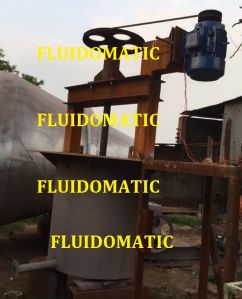
Lead Refining Plant
Get Price Quote
The Lead Bullion is fed into a refining kettle. Lead bullion contains many other metallic impurities including antimony, arsenic, copper, tin and zinc. Refining Process of Lead in Detail : Removal of Copper : Copper is the first of the impurities to be removed. The lead bullion is melted at about 300–600 °C and held just above its melting-point when solid copper rises to the surface and is skimmed off. Sulfur is stirred into the melt to facilitate the operation by producing a dry powdery dross which is more readily removed. Once copper has been removed, there are a number of processes available for the extraction of the other impurities from the bullion. These include, in which elements are removed one or more at a time in several stages. Removal of antimony, arsenic and tin : After the removal of copper, the next step is to remove antimony, arsenic and tin. There are two methods available — the softening process (so-called since these elementsare standard hardeners for lead) and the Harris process. In the softening process, the lead bullion is melted and agitated with an air blast, causing preferential oxidation of the impurities which are then skimmed off as a molten slag. In the Harris process, the molten bullion is stirred with a flux of molten sodium hydroxide and sodium nitrate or anothersuitable oxidizing agent. The oxidized impurities are suspended in the alkali flux in theform of sodium antimonate, arsenate and stannate, and any zinc is removed in the form of zinc oxide. Removal of silver, gold & Bismuth : After the removal of antimony, arsenic and tin, the softened lead may still containsilver and gold, and bismuth. The removal of the precious metals by the Parkesprocess is based on the fact that they are more soluble in zinc than in lead. In this process,the lead is melted and mixed with zinc at 480 °C. The temperature of the melt is graduallylowered to below 419.5 °C, at which point the zinc (now containing nearly all the silverand gold) begins to solidify as a crust on the surface of the lead and can be skimmed off.An alternative procedure, the Port Pirie process, used at the Port Pirie refinery in Australia,is based on similar metallurgical principles. Removal of zinc : The removal of the precious metals leaves zinc as the main contaminant of the lead.It is removed either by oxidation with gaseous chlorine or by vacuum distillation. Thelatter process involves melting the lead in a large kettle covered with a water-cooled lidunder vacuum. The zinc distils from the lead under the combined influence of temperatureand reduced pressure and condenses on the underside of the cold lid.Refined lead is poured into moulds and ingots are formed. These ingots are then sent to storage. For integrated Production of Lead Oxide, Refined Lead is casted into Balls. (to be fed directly to Lead oxide Ball Mill). About Lead Refining : Lead recycled from used lead acid batteries or other sources (Secondary Smelting) via the Mini Blast Furnace or Rotary Furnace route, contains lot of contamination and undesired components. On the other hand, Lead required for battery manufacturing is either soft Lead with 99.97% purity or hard Lead of varying Antimony compositions.In order to make quality of lead suitable for its different uses,different variations of pot melting processes are employed. These includes : “Re-Melting” for removal of slag, “Refining” for attaining required purity levels and “Alloying” for producing various alloys of lead. The equipment used is the same, the consumables and the processes, however, differ. Refining Pot Details : The Refining Pot (or Refining Kettle or Alloying Pot, as it is variously called), is a mechanical mixing device with a pot and a heating arrangement. The inner pot is made of heavy MS plate with dish end bottom. It is placed within a jacket of refractory bricks, which in turn, are protected by an outer cover of MS plate with reinforcements. The pot is covered at the top with opening for feeding lead ingots and is provided with an electro-mechanical mixer. At the bottom, a heating source, usually an oil fired/ Diesel burner& sometimes by Wood burning is provided to heat the pot and to melt the lead. Once lead melts, impurities are skimmed and removed and any consumables required are added. Lead is then drained from the pot through an outlet pipe and valve. Capacity of such pots depends upon the requirements of particular units. Standard pot capacities made are from 3.0 Tons per Batch to20.0 Tons per Batch. Higher capacity pots are also manufactured as required by any particular establishment. Melting pots are installed both with and without accessories which may include Ingot Casting Machine, Ball Making Machine (where Ball Mills are installed down the line), Air Pollution Control Systems, Jib Cranes etc.Production Process :Melting Processes have been grouped as Re-Melting Process Refining Process Alloying Process Re-Melting Process : This process is undertaken for value addition to the recycled lead from furnaces. Lead is melted in the pot and major impurities are skimmed from it to make it saleable in the market.Refining Process : Lead is melted in the pot, additives such as Sulphur, Wooden Powder and Coke Breeze are added and mixed gently followed by dross removal. Thereafter, Tin is added to remove Copper and temperature is increased to 550-6000C. Further, additives such as Sodium Nitrate & Caustic Soda are added to remove Antimony. This process is repeated to get the desired purity of lead. Alloying Process : Lead is melted in the pot; additives such as Sulphur, Wooden Powder & Coke Breeze are added and mixed gently followed bydross removal. Thereafter, Tin & Antimony are added to the liquid metal to get the desired grade of Lead.Melting processes lead to generation of air pollution at the following stages : Initial heating and melting generates fumes Drossing with sulphur, wooden powder and coke breeze generates lot of smoke and dust particles Further heating for Refining and Alloying with different chemicals generates fumes and dust particles. Hence, to meet various goals of maintaining employees' health, factory environments as well as regulatory requirements, it becomes imperative to get high end Air Pollution Control Systems to be installed with the Melting Pots.Characteristics of Air Pollution generated in Melting Pot : Dust : 500-600 mg/Nm3 Temperature : 60-80° C Gases : Fumes and Dust Discharge Characteristics required as per Norms : Dust - Less than 50 mg/Nm3 Lead ( Pb) - Less than 10 mg/Nm3 Temperature - 50-60° C Gases - Not Detectable Selection & Detailson Technology for Air Pollution Control : Based on the Parameters and the Standards mentioned, the following technology is adopted for Air Pollution Control Systemin Melting Pot is Pulse Jet based Bag House Filtration System

Edible Oil Refinery Plant
4,000,000 Per Piece
1 Piece (MOQ)
Features Low neutral oil loss Consistent and superior quality output Robust equipments and Machinery Long life of the plant Most economical price Lowest possible utility consumption

non-edible oil refining plant
1 - 2 Per set
1 set (MOQ)

Waste Lube Refining Plant
20,000,000 Per Piece

Cooking Oil Refinery Plants
Get Price Quote
Located at New Delhi(India), we are reckoned for providing excellent array of products throughout the country. Our investment in the well-structured warehouse has paid off well. We have successfully installed up-to-the-minute warehouse management software to keep the entire lot in a safe and organized manner.
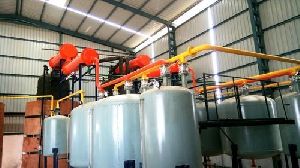
Waste Oil Refining Plant
Get Price Quote
Irrespective of it being a wholesale or retail order, we can deliver it timely. We have shipping resources on reserve all year round to make sure delivery of our items is bother free. Our dedicated staff is always on their toes to make certain that the raw material used is of high grade and certified by the experts as well.

Degumming Oil Plant
Get Price Quote
We are offering degumming oil plant. Muezhest degumming method consists of a mere association of the rock oil. Bound impurities like phospholipids, gums and proteins square measure soluble in oil in their anhydrous kind, however insoluble once they're hydrous. This can be however the hydratable phospholipids square measure aloof from the oil. A part of the constituents but stay within the oil, and an acid treatment is required to get rid of them. water degumming is additional usually dispensed within the extraction plant instead of within the plant, lest foots ought to conglomerate within the rock oil intermediate tanks. muez-hest provides a extremely effective dry degumming plant that involves few crucial stages- mixture of oxygen acid acid and rock oil, victimization high shear mixer and reaction tank. The method style is well established and really effective for numerous ftas and oil. thumb(26) salient options of the method are: water degumming may be dispensed within the extraction plant. The separated gums square measure supplemental to the deoiled meal within the toaster. To produce phospholipid, these gums square measure dried individually. Crude oil is pumped-up incessantly to an in line mixer wherever in pre-calculated amount of water is supplemental. Oil water mixture is fed to the association tank and allowed comfortable duration for the gums to agglomerate on association and pumped-up to apparatus wherever the oil and hydrous gums square measure separated and pumped-up to storage. Some particles that aren't removed by water degumming would like acid treatment. degummed oil from the apparatus is fed to a knife mixer, wherever it's intensively mixed with requisite amount of focused element mixture and is allowed a quick holding time within the mixer and therefore the precipitation of phosphatides and trace metals occur.

salt refining plant
Get Price Quote

edible oil refinery plants
Get Price Quote

Edible Oil Refineries
Get Price Quote
We are offering edible oil refineries. With decades of experience and expertise in vegetable oil refining, we offer every step from raw oil processing to refining for any seed oil. We have delivery capability from single section to a complete refinery plant. We focus on energy conservation, lowest utility requirement, low effluent discharge, high yields and better quality products. our strengths are: experience of having executed many vegetable oil refining plants process engineering and project handling capability in-house process simulation, design programs and autocad facilities own manufacturing facility for the core components and equipments salient process steps are centrimix degumming, neutralising, dewaxing, washing and eco2flex deodorization. Quantity : 3 plants per month payment terms : negotiable, lc or 40% advance, balance on proforma invoice packaging : standard specifications : process performance guaranteed for 6 months quality : iso 9001:2008
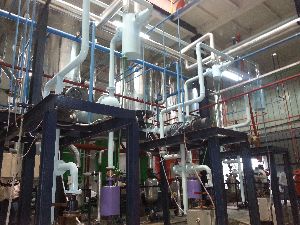
Waste Lube Oil Refining Plant
Get Price Quote
Promoted By N.R.D.C (National Research & Development Centre. Jhamrudhpur, New Delhi) Ministry of Science,Govt of India As per the Central Pollution Control Board Norms Capacities For Continuous Process, with Wiped Film Molecular Distillations, Capacities : 200 Liters per Hour to 5,000 Liters per Hour For Smi-continuous Process : Capacities: 12,000 Liters per Day to 75,000 Liters per Day Salient Features : 38 Projects Supplied Till Dec 2014, Worldwide clay Free, Thin Film, Continuous Molecular Distillation. the Distilled Base Oil is Processed with the Re-usable, Polymer-sm to Bring Down Odour, Color and Poly Nuclear Aromatics Waste Oil Re-refining Plants : 5000 litres per hour to 10,000 litres per hour feed rate. Polymer treatment or column catalyst for post distillation of base oils Process : High Vacuum, Continuous molecular thin film distillation High vacuum

Continue Lube Oil Refining Plant
Get Price Quote
Continue Lube Oil Dehydration and Distillation Plant

Metal Refining Plant
Get Price Quote
1 Set (MOQ)

Gold Refinery Plant
2,500,000 Per Piece

Palm Oil Refinery Plant
Get Price Quote
1 unit (MOQ)
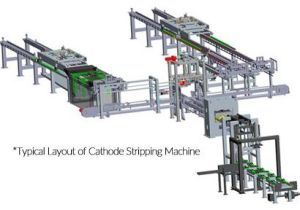
Aluminium Refining Systems
Get Price Quote
Modtech has indigenously designed the following machines to cater to the requirements of CopperAluminium Refining Industry These machines are highly complicated and comprise of power pack hydraulic motors, around 25-30 hydraulic cylinders, accumulators, 10-15 pneumatic cylinders, suction cups, photo-sensors, proximity switches, chain conveyors, chiseling unit, strapping machine, PLC system etc.The customers have saved millions of rupees by procuring such machines from Modtech.Modtech has supplied CSM, ASWM to customers like Hindalco, Birla Copper, Somika and Sterlite Industries etc.

Automatic Gold Refining Plants
Get Price Quote
With the inclusion of advanced knowledge and innovative machines in all our processes, we are engaged in manufacturing and supplying a broad assortment of Automatic Gold Refining Machine. It is mainly used by goldsmith. It is a safe as well as reliable process of removing gold. It t is designed utilizing high grade material, procured from reliable sources of the industry as per the defined industry norms. Automatic Gold Refining Machine is widely known for its durability and quality. Alloy Batch Charge 1 Kg to 100 Kg. Working Cycle Time In – 24 Hr 3 Batches Purity Can Be Obtained – Form 999.5 to 999.8-9/1000 Electric Power Supply – 3Ph

Oil Refinery Plant
Get Price Quote

Edible Oil Refinery Plant
Get Price Quote

Palm Oil Refinery
5 Per Piece
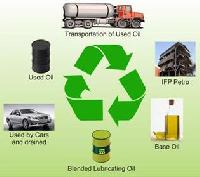
Used Oil Re-Refining
Get Price Quote
IFP is a process technology company with over 30 years core experience in re-refining of used lubricating and industrial oils. IFP started its technological journey in the year 1977 with technical collaboration with Indian Institute of Petroleum (IIP) Dehradun by commissioning 500 TPA adopting the conventional Acid Clay process. In pursuit of producing better quality and higher yield, IFP graduated its technologies from the Acid Clay process to 3 stage vacuum distillation process plant of 6000 KLA in 2005. IFP recognizes that oil has an amazing capacity to be recycled and reused indefinitely with no loss of quality. IFP is committed to conserve, recycle and re-use precious petroleum oil for the next generation. IFP conserves more than 4000 K.L lubricating oil every year. IFP has a long list of satisfied customers going back 3 decades who have benefited from its refining facilities. Used oil has been termed hazardous by Ministry of Environment & Forests, GOI and as per Gazette Notification the used oil has to be disposed to only registered recyclers approved by CPCB. IFP is registered with CPCB (Ministry of Environment & Forest), Ministry of Petroleum and Chief Controller of Explosives and is fully authorized to handle used oil. IFP Provides customers with professional quality and services : IFP purchases used oil on annual rate contract basis at the best market price. It has an efficient team in place to collect used oil.IFP undertakes job work whereby used oil generated by the industries is recycled and blended to bring it back to its original specifications. This innovative approach ensures reduction in expenditure of lubricants and more than 50% savings. It also means that customers do not generate hazardous waste.

Titanium Refineries
20,000 - 40,000 Per nos

vegetable oil refineries
Get Price Quote
We are offering vegetable oil refineries system is designed to fully refine(physical and chemical refining), i.e. Degum neutralize, bleach, strip and deodorize and dewaxed oils. The degumming neutralizing system are used as the first step in chemical refining referred to as neutralizing.